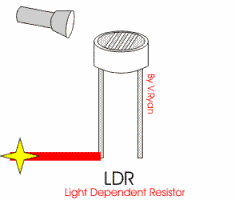By thinknut.blogspot.com
How LDR Works ???

LDRs or Light Dependent Resistors are very useful especially in light/dark sensor circuits. Normally the resistance of an LDR is very high, sometimes as high as 1000 000 ohms, but when they are illuminated with light resistance drops dramatically.



How LDR Works ???

LDRs or Light Dependent Resistors are very useful especially in light/dark sensor circuits. Normally the resistance of an LDR is very high, sometimes as high as 1000 000 ohms, but when they are illuminated with light resistance drops dramatically.
OR
An LDR is a component that has a resistance that changes with the light intensity that falls upon it. They have a resistance that falls with an increase in the light intensity falling upon the device.
Symbol :

Working :
The resistance of an LDR may typically have the following resistances.
| Daylight | = 5000 ohms |
| Dark | = 20000000 ohms |
You can therefore see that there is a large variation between these figures. If you plotted this variation on a graph you would get something similar to that shown by the graph to the right.

The animation opposite shows that when the torch is turned on, the resistance of the LDR falls, allowing current to pass through it.

| Circuit Wizard software has been used to display, the range of values of a ORP12, LDR . When a light level of 1000 lux (bright light) is directed towards it, the resistance is 400R (ohms). When a light level of 10 lux (very low light level) is directed towards it, the resistance has risen dramatically to 10.43M (10430000 ohms).
This is an example of a light sensor circuit :
When the light level is low the resistance of the LDR is high. This prevents current from flowing to the base of the transistors. Consequently the LED does not light. However, when light shines onto the LDR its resistance falls and current flows into the base of the first transistor and then the second transistor. The LED lights. The preset resistor can be turned up or down to increase or decrease resistance, in this way it can make the circuit more or less sensitive.  |








0 comments:
Post a Comment